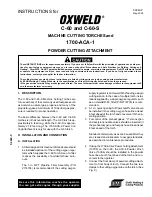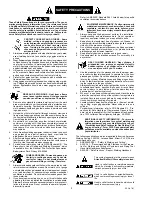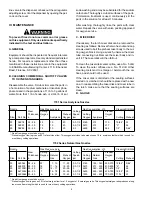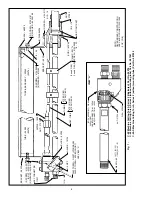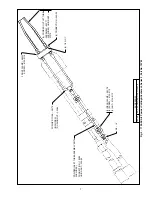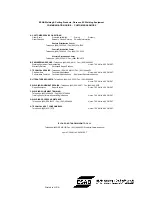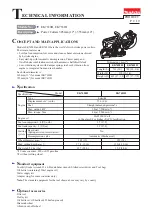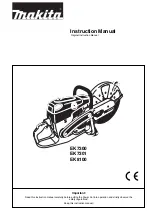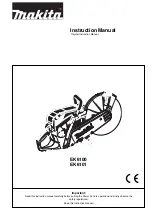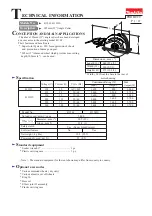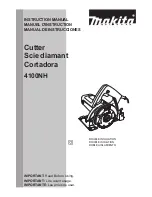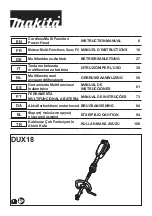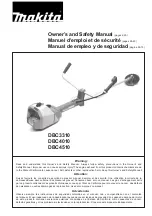
2
These Safety Precautions are for your protection. They sum-
marize precautionary information from the references listed
in Additional Safety Information section. Before performing any
installation or operating procedures, be sure to read and fol-
low the safety precautions listed below as well as all other
manuals, material safety data sheets, labels, etc. Failure to ob-
serve Safety Precautions can result in injury or death.
PROTECT YOURSELF AND OTHERS - Some
welding, cutting and gouging processes are
noisy and require ear protection. Hot metal can
cause skin burns and heat rays may injure
eyes. Training in the proper use of the pro-
cesses and equipment is essential to prevent
accidents. Also:
1.
Always wear safety glasses with side shields in any work area,
even if welding helmets, face shields, or goggles are also re-
quired.
2.
Wear flameproof gauntlet type gloves, heavy long-sleeve shirt,
cuffless trousers, high-topped shoes, and a welding helmet or
cap for hair protection, to protect against hot sparks and hot
metal. A flameproof apron may also be desirable as protection
against radiated heat and sparks.
3.
Hot sparks or metal can lodge in rolled up sleeves, trousers
cuffs, or pockets. Sleeves and collars should be kept buttoned,
and open pockets eliminated from the front of clothing.
4.
Protect other personnel from hot sparks with a suitable non-
flammable partition or curtains.
5.
Use goggles over safety glasses when chipping slag or grind-
ing. Chipped slag may be hot and can travel considerable dis-
tances. Bystanders should also wear goggles over safety
glasses.
FIRES AND EXPLOSIONS - Heat from a flame
can act as an ignition source. Hot slag or sparks
can also cause fires or explosions. Therefore:
1.
Remove all combustible materials well away from the work
area or completely cover the materials with a protective non-
flammable covering. Combustible materials include wood,
cloth, sawdust, liquid and gas fuels, solvents, paints and coat-
ings, paper, etc.
2.
Hot sparks or hot metal can fall through cracks or crevices in
floors or wall openings and cause a hidden smoldering fire on
the floor below. Make certain that such openings are protected
from hot sparks and metal.
3.
Do not weld, cut, or perform any other hot work on materials,
containers, or piping until it has been completely cleaned so
that no substances on the material can produce flammable or
toxic vapors. Do not do hot work on closed containers. They
may explode.
4.
Have fire extinguishing equipment handy for instant use, such
as a garden hose, a pail of water or sand, or portable fire
extinguisher. Be sure you are trained in its use.
5.
After completing operations, inspect the work area to be sure
that there are no hot sparks or hot metal which could cause a
later fire. Use fire watchers when necessary.
6.
For additional information, refer to NFPA Standard 51B, Fire
Prevention in Use of Cutting and Welding Processes, which
is available from the National Fire Protection Association,
Batterymarch Park, Quincy, MA 02269.
FUMES AND GASES - Fumes and gases, par-
ticularly in confined spaces, can cause dis-
comfort or injury. Do not breathe fumes or
gases from welding or cutting, Therefore:
1.
Always provide adequate ventilation in the work area by natu-
ral or mechanical ventilation means. Do not weld, cut, or gouge
on materials such as galvanized steel, stainless steel, copper,
zinc, lead, beryllium, or cadmium unless positive mechanical
ventilation is provided. Do not breathe fumes and gases from
these materials.
2.
If you develop momentary eye, nose, or throat irritation while
operating, this is an indication that ventilation is not adequate.
Stop work at once and take necessary steps to improve venti-
lation in the work area. Do not continue to operate if physical
discomfort persists.
3.
Refer to ANSI/ASC Standard Z49.1 listed below for specific
ventilation recommendations.
EQUIPMENT MAINTENANCE - Faulty or improperly
maintained equipment, such as torches, hoses and
regulators, can result in poor work, but even more
important, it can cause injury or death through fires.
Therefore:
1.
Always have qualified personnel perform the installation,
troubleshooting, and maintenance work. Do not operate or
repair any equipment unless you are qualified to do so.
2.
Keep all oxy-fuel equipment free of grease or oil. Grease, oil,
and other similar combustible materials, when ignited, can burn
violently in the presence of oxygen.
3.
Do not abuse any equipment or accessories. Keep equipment
away from heat and wet conditions, oil or grease, corrosive
atmospheres and inclement weather.
4.
Keep all safety devices in position and in good repair.
5.
Use equipment for its intended purpose. Do not modify it in
any manner.
GAS CYLINDER HANDLING - Gas cylinders, if
mishandled, can rupture or explode violently.
Sudden rupture of a cylinder, valve or relief de-
vice can injure or kill you. Therefore:
1.
Use the proper gas for the process and use the proper pres-
sure reducing regulator designed to operate from the com-
pressed gas cylinder. Do not use adaptors to mount the regu-
lator on the cylinder. Maintain hoses and fittings in good con-
dition. Follow manufacturers operating instructions for mount-
ing the regulator to the gas cylinder.
2.
Always secure cylinders in an upright position by chain or strap
to suitable hand trucks, benches, walls, post, or racks. Never
secure cylinders to work tables or fixtures where they may
become part of an electrical circuit.
3.
When not in use, keep cylinder valves closed. Have the valve
protection cap in place on top of the cylinder if no regulators is
installed. Secure and move cylinders by using suitable hand
trucks. Avoid rough handling of cylinders.
4.
Locate cylinders away from heat, sparks, or flame of a weld-
ing, cutting, or gouging operation. Never strike an arc on a
cylinder.
5.
For additional information, refer to CGA Standard P-1, Pre-
cautions for Safe Handling of Compressed Gases in Cylin-
ders:, which is available from the Compressed Gas Associa-
tion, 1235 Jefferson Davis Highway, Arlington, VA 22202.
ADDITIONAL SAFETY INFORMATION - For more in-
formation on safe practices for oxy-fuel welding and
cutting equipment, ask your distributor for a copy of
Precautions and Safe Practices for Gas Welding, Cut-
ting, and Heating, Form 2035. Gas apparatus safety
guidelines are also available on video cassettes from
your distributor.
The following publications, which are available from the American
Welding Society, 550 N.W. LeJuene Road, Miami, FL 33126, are
recommended to you:
1.
ANSI/AWS Z49.1 - Safety in Welding and Cutting.
2.
AWS F4.1 - Recommended Safe Practices for the Prepara-
tion for Welding and Cutting of Containers and Piping That
Have Held Hazardous Substances/
3.
AWS SP - Safe Practices - Reprint, Welding Handbook.
Used to call attention to immediate hazards
which, if not avoided, will result in immediate,
serious personal injury or loss of life.
Used to call attention to potential hazards
which could result in personal injury or loss of
life.
Used to call attention to hazards which could
result in minor personal injury.
This symbol appearing in this manual means
Attention! Be Alert! Your safety is involved.
SP-GA 7/97
SAFETY PRECAUTIONS

